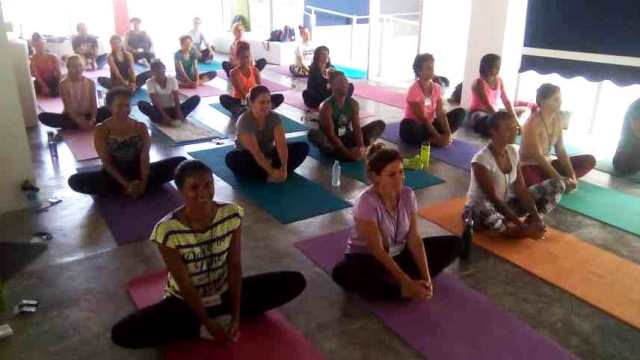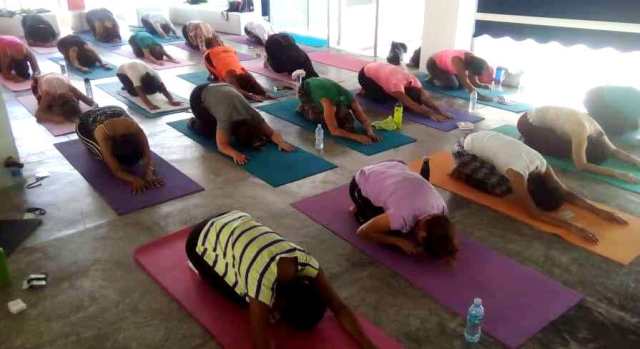An Art of Living Instructor in Cuba
By Regina Cano

HAVANA TIMES – I recently had the pleasure of sitting down and talking to Javier Cerezuela, who is originally from Neuquen, Argentina. He has been a journalist and Art of Living instructor for more than ten years.
“The Art of Living” came to Cuba in 2015 for the first time and it already has some followers, especially in Havana.
HT: What brings you to Cuba?
Javier Cerezuela: It’s my first time on the island. I’m the program coordinator for Costa Rica, Panama and the Dominican Republic. We normally go and visit volunteers.
I came this time specially to help with some training. We hold courses, conferences, talks, to train more people so there are more local instructors. We already have an instructor in Cuba, Katy (Katia Peon Valdes).
We now have more than 10 volunteers who want to train here to become instructors, and a team of about 30 to 40 active volunteers, who come together every week to do breathing exercises and other practices. So, it has grown a lot, quite quickly, and sustainably.
We already have over 1000 instructors in Argentina. We are some 2000 in Latin America and the organization is growing as a result.
HT: What are your intentions?
JC: The Art of Living is a global organization which is committed to teaching breathing and meditation techniques. Yoga techniques to form non-impulsive individuals and to reduce violence in society. So that people can learn to deal with their thoughts and emotions. So they can learn to be happier, to have well-being and lead a life in which they are more connected with one’s self.
We are in a hundred-and-fifty-something countries. Our intentions in Cuba are the same as they are in every other country. We seek global peace and we need everyone to understand how to be happier and respect one other first.

HT: What can you tell us about your volunteers and courses?
J: People come to The Art of Living, take their first course and most of them look for a way to join the organization. They begin their training as volunteers, who help organize courses and learn so they can then go on to teach.
We run open courses for the public. At The Art of Living’s centers, or in rented spaces, schools, universities, prisons. In places experiencing climatic problems: earthquakes or volcano eruptions or post-traumatic places, after wars.
The Happiness Program is our first program. A breathing course, which teaches people the Sudarshan Kriya technique, which works with the body and mind’s biorhythms to get rid of toxins, stress and bring the mind to the present.
You take a tool home that you will have for the rest of your life.
Then, we have courses to further develop people’s knowledge of meditation, yoga, asanas, positions, as well as silence courses.
All of these programs are available in Cuba. You can take all of them throughout the course of a year, more or less.
HT: What are your impressions of Cuba?
It’s beautiful! I travel all over Central America and honestly, my experience here in Cuba has been great. I loved the city, the people are very friendly, very affectionate. I came across a lot of joy, a lot of gratitude.
We gave a yoga course for thirty people. We will hold the conference: Just let it flow, which over 100 people are expected to attend, and we will teach them how you can live without anxiety for the future and torment from the past. Connecting with the present and being happier. Living without all of these ghosts in your mind.
We have another conference to give with over a hundred people and a meditation workshop, so people can learn a little bit more about meditation.
They are small introductory workshops so they can have a taster and become interested in taking the main course.
HT: Are there any differences between Central America and Cuba?
J: Human beings have more or less the same problems all over the world, because our minds are more or less the same. It’s really beautiful how every country has its own culture and traditions. That is to say, every place has something very unique, but it is also like every other country at the same time.
It’s all a question of having this awareness to hold onto your own culture, but also respecting others’, because none are any better or worse.
I feel blessed that I am able to get to know so many cultures and also realize that we can live in peace and harmony in all of them.

HT: Have more instructors come to Cuba from Argentina than any other country?
J: We run a course every month. We have a very active instructor and instructors from abroad are always visiting. We have this custom at The Art of Living, of creating a network among instructors, so they can keep the energy flowing. And every instructor is like a different flavor of ice cream.
We have also had instructors come from India, but it just so happens that Argentina has a great faculty for training Art of Living instructors, so they collaborate and come to other countries.
HT: Does the Art of Living work for Argentinians?
J: It works all over the world, not just for Argentinians. The country depends a lot on its economic crisis, its political crises, which it has every 10 years, but I believe these crises have also helped The Art of Living, because people seek spirituality, love.
When the outside world doesn’t satisfy people, they look within and this has been the appeal for many people, and Argentina is a very spiritual country. Meditation exercises have always been very successful.
HT: Does the Art of Living interfere in the economic and political landscape?
J: No. We are a non-political and non-religious organization, which also explains why we are in so many places.
We have instructors of all political and religious stripes because they don’t have anything to do with the Art of Living.
Nobody asks you at an Art of Living course what you think politically, or what religion you follow, we only try to teach you tools that can help you become happier and more joyful.
We humans are all the same and we all have the same right to have a body free of disease, a mind free of trauma and a free spirit. It doesn’t matter what country you were born in, it doesn’t matter what religion you follow or what it is that is going on in your life.

HT: Is there anything else you would like to say?
J: You can have a happy life, beyond the stormy waters Life throws your way because it isn’t a matter of having a life free of stormy weather, but a life that is well-lived and lived to the max. Being happy with what you are dealt with and we are able to do this, especially when you have techniques, tools, that can help you to get there.
I invite all of you to find your own tools. Of course, the Art of Living isn’t the only place where you can get them, there are many places, but the Art of Living’s techniques are very effective, great and powerful. So, you are all welcome.
HT: Thank you.
J: It was my pleasure.
——
The Art of Living contacts:
Email: [email protected] / +53 5664246 (Katia Valdes Peon) / [email protected] (Rayza Albuquerque)
Links:
–“The Art of Living in Cuba” (Interview with Andrés Oscar Lahera Carbó) (2018)
-First America meditates gathering in Cuba (2018)






What do you know, when you live in an ivory tower ? I say very little. Get out there and mingle with the people and then you will be a better decision maker if that’s your inclination in life.